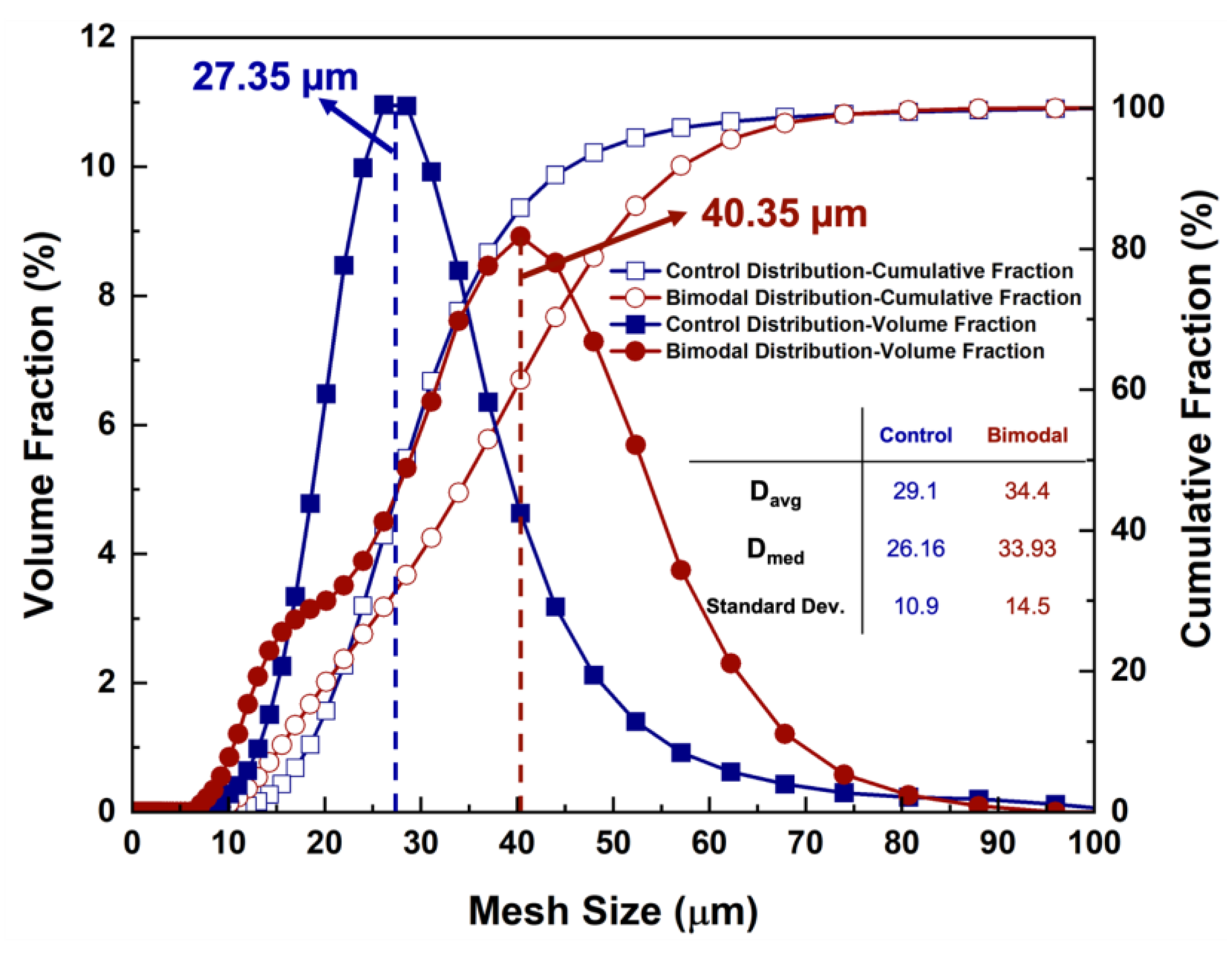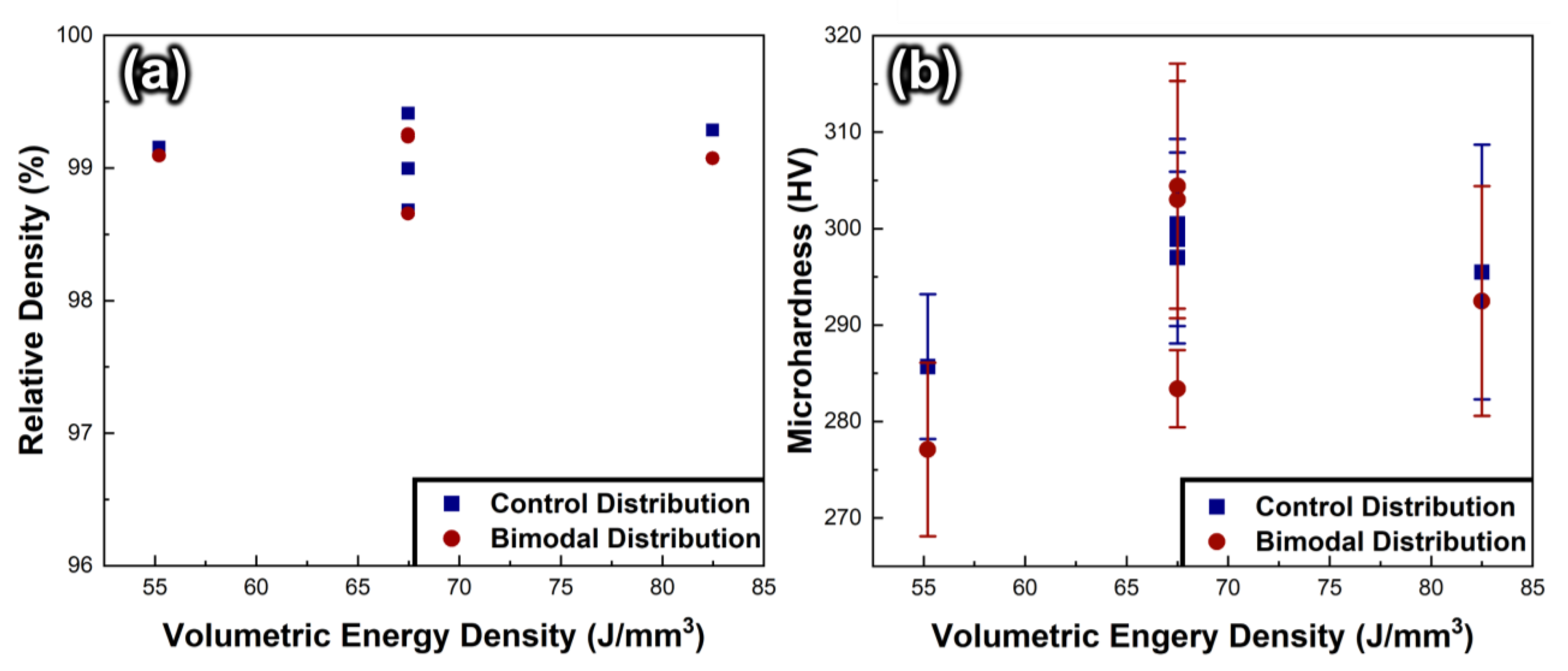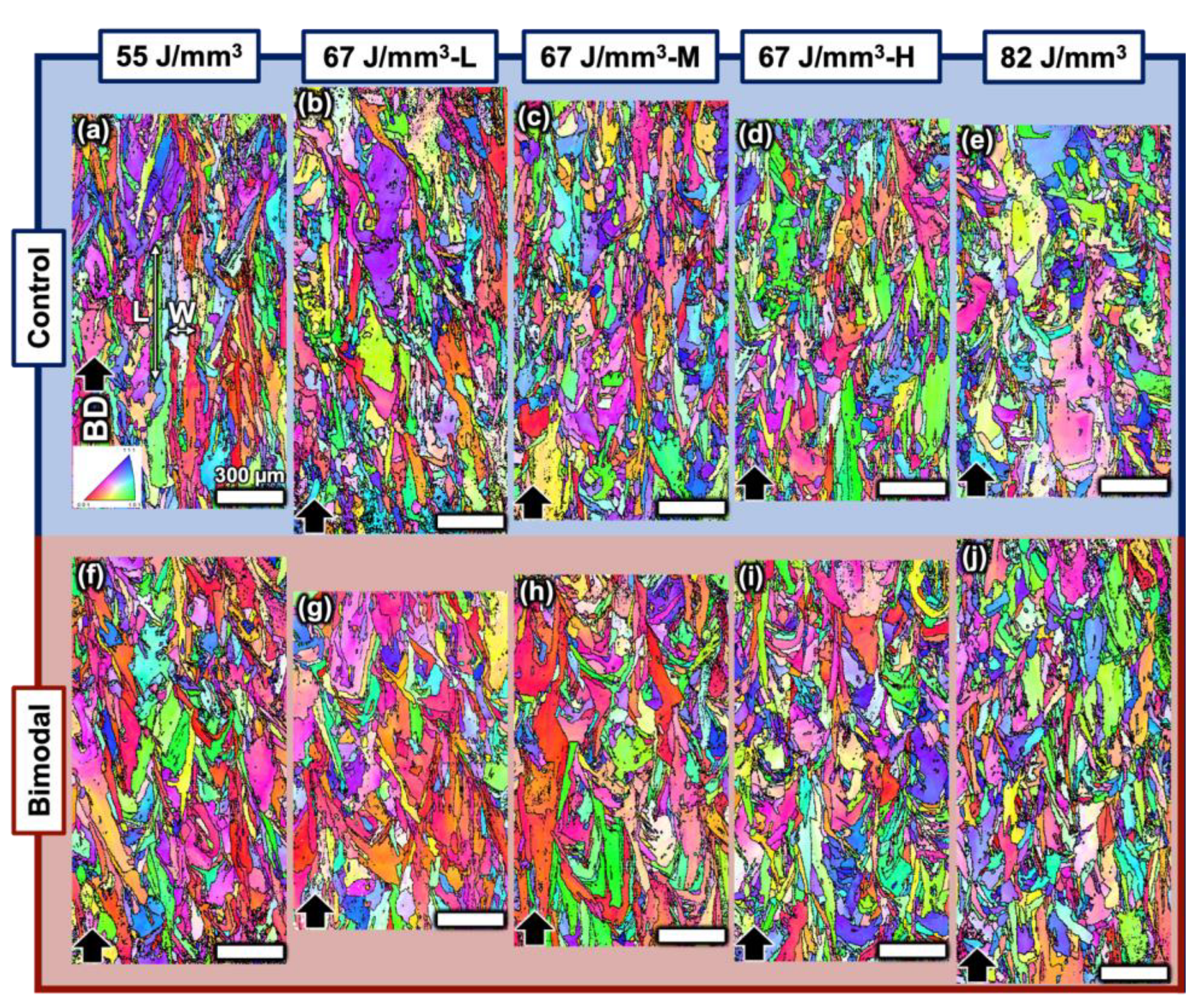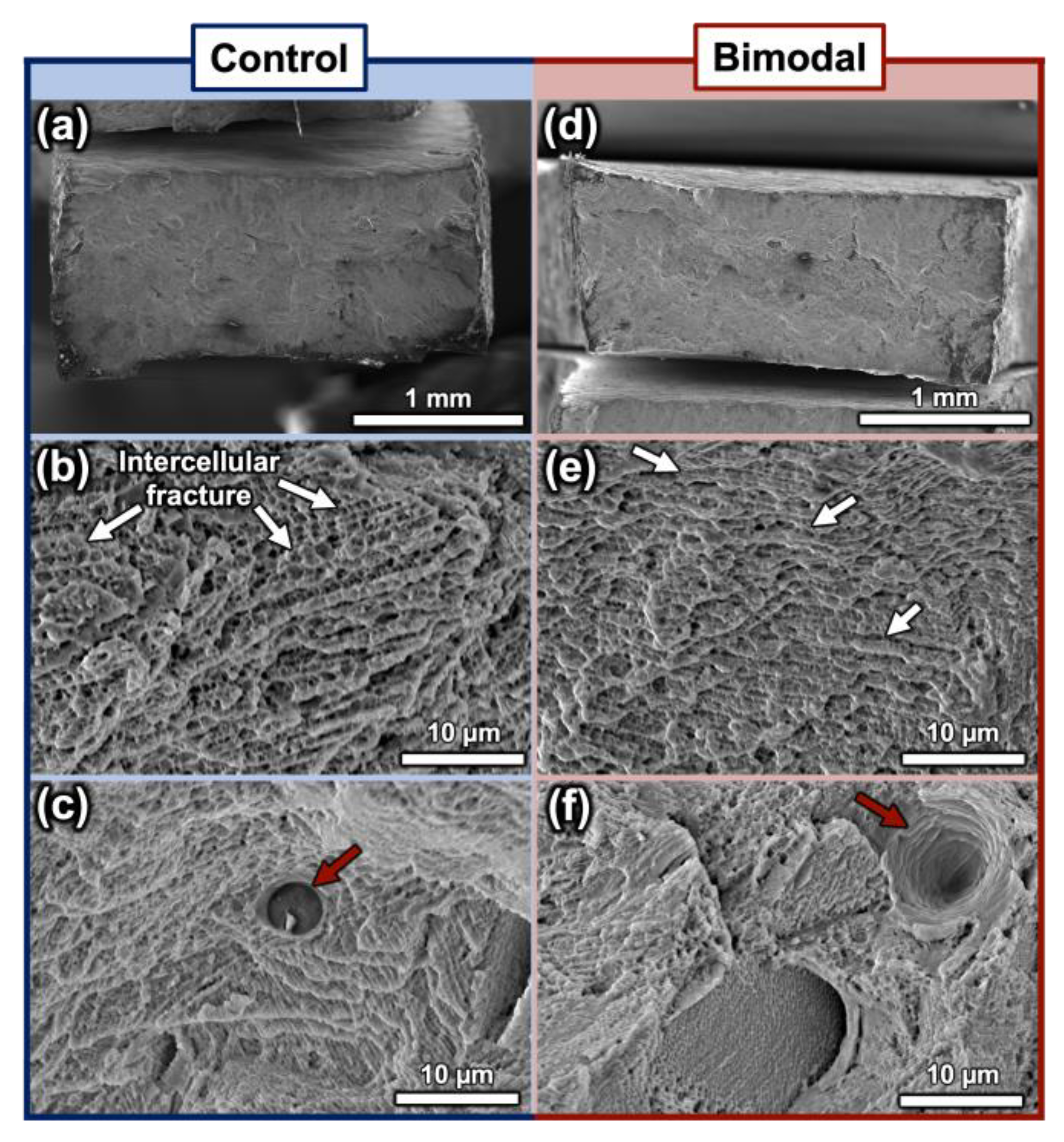The Influence of Powder Particle Size Distributions on Mechanical Properties of Alloy 718 by Laser Powder Bed Fusion
Abstract
:1. Introduction
2. Materials and Methods
3. Results
4. Discussion
5. Conclusions
Author Contributions
Funding
Data Availability Statement
Acknowledgments
Conflicts of Interest
References
- Bourell, D.; Kruth, J.P.; Leu, M.; Levy, G.; Rosen, D.; Beese, A.M.; Clare, A. Materials for additive manufacturing. CIRP Ann. Manuf. Technol. 2017, 66, 659–681. [Google Scholar] [CrossRef]
- Moghimian, P.; Poirié, T.; Habibnejad-Korayem, M.; Zavala, J.A.; Kroeger, J.; Marion, F.; Larouche, F. Metal powders in additive manufacturing: A review on reusability and recyclability of common titanium, nickel and aluminum alloys. Addit. Manuf. 2021, 43, 102017. [Google Scholar] [CrossRef]
- Mustafa, K.; Mohammad, U. A Review: Chill-Block Melt Spin Technique, Theories & Applications; Bentham Science Publishers: Sharjah, United Arab Emirates, 2013; Volume 5, p. 134. [Google Scholar]
- Neikov, O.D.; Naboychenko, S. Handbook of Non-Ferrous Metal Powders: Technologies and Applications; Elsevier: Amsterdam, The Netherlands, 2009; p. 114. [Google Scholar]
- Richter, J.; Torrent, C.J.J.; Krochmal, M.; Wegener, T.; Vollmer, M.; Niendorf, T. A comparative study using water atomized and gas atomized powder in laser powder bed fusion—Assessment of the fatigue performance. Int. J. Fatigue 2023, 168, 107468. [Google Scholar] [CrossRef]
- Sehhat, M.H.; Sutton, A.T.; Hung, C.-H.; Newkirk, J.W.; Leu, M.C. Investigation of Mechanical Properties of Parts Fabricated with Gas- and Water-Atomized 304L Stainless Steel Powder in the Laser Powder Bed Fusion Process. JOM 2022, 74, 1088–1095. [Google Scholar] [CrossRef]
- Anderson, I.E.; White, E.M.; Dehoff, R. Feedstock powder processing research needs for additive manufacturing development. Curr. Opin. Solid State Mater. Sci. 2018, 22, 8–15. [Google Scholar] [CrossRef]
- Wang, L.; Tan, Z.; Wang, S.; Liu, W.; Hao, J.; Zhang, X.; Deng, S.; Yu, C.; Zheng, H.; Zeng, Z.; et al. Atomization gases dependent mechanical properties in the laser powder bed fusion manufactured 304L stainless steel. J. Mater. Process. Technol. 2023, 316, 117966. [Google Scholar] [CrossRef]
- Shi, Y.; Lu, W.; Sun, W.; Zhang, S.; Yang, B.; Wang, J. Impact of gas pressure on particle feature in Fe-based amorphous alloy powders via gas atomization: Simulation and experiment. J. Mater. Sci. Technol. 2022, 105, 203–213. [Google Scholar] [CrossRef]
- Ruan, G.; Liu, C.; Qu, H.; Guo, C.; Li, G.; Li, X.; Zhu, Q. A comparative study on laser powder bed fusion of IN718 powders produced by gas atomization and plasma rotating electrode process. Mater. Sci. Eng. A 2022, 850, 143589. [Google Scholar] [CrossRef]
- Lefebvre, L.; Whiting, J.; Nijikovsky, B.; Brika, S.; Fayazfar, H.; Lyckfeldt, O. Assessing the robustness of powder rheology and permeability measurements. Addit. Manuf. 2020, 35, 101203. [Google Scholar] [CrossRef]
- Zegzulka, J.; Gelnar, D.; Jezerska, L.; Prokes, R.; Rozbroj, J. Characterization and flowability methods for metal powders. Sci. Rep. 2020, 10, 21004. [Google Scholar] [CrossRef]
- Brika, S.E.; Letenneur, M.; Dion, C.A.; Brailovski, V. Influence of particle morphology and size distribution on the powder flowability and laser powder bed fusion manufacturability of Ti-6Al-4V alloy. Addit. Manuf. 2020, 31, 100929. [Google Scholar] [CrossRef]
- Mussatto, A.; Groarke, R.; O’neill, A.; Obeidi, M.A.; Delaure, Y.; Brabazon, D. Influences of powder morphology and spreading parameters on the powder bed topography uniformity in powder bed fusion metal additive manufacturing. Addit. Manuf. 2021, 38, 101807. [Google Scholar] [CrossRef]
- Farzadfar, S.A.; Murtagh, M.J.; Venugopal, N. Impact of IN718 bimodal powder size distribution on the performance and productivity of laser powder bed fusion additive manufacturing process. Powder Technol. 2020, 375, 60–80. [Google Scholar] [CrossRef]
- Jacob, G.; Brown, C.U.; Donmez, A. The Influence of Spreading Metal Powders with Different Particle Size Distributions on the Powder Bed Density in Laser-Based Powder Bed Fusion Processes; US Department of Commerce, National Institute of Standards and Technology: Gaithersburg, MD, USA, 2018. Available online: https://www.nist.gov/publications/influence-spreading-metal-powders-different-particle-size-distributions-powder-bed (accessed on 18 June 2023).
- A Kuznetsov, P.; Shakirov, I.V.; Zukov, A.S.; Bobyr’, V.V.; Starytsin, M.V. Effect of particle size distribution on the structure and mechanical properties in the process of laser powder bed fusion. J. Physics Conf. Ser. 2021, 1758, 012021. [Google Scholar] [CrossRef]
- Martin, J.H.; Barnes, J.E.; Rogers, K.A.; Hundley, J.; LaPlant, D.L.; Ghanbari, S.; Tsai, J.-T.; Bahr, D.F. Additive manufacturing of a high-performance aluminum alloy from cold mechanically derived non-spherical powder. Commun. Mater. 2023, 4, 39. [Google Scholar] [CrossRef]
- James, W.B.; Samal, P.; Newkirk, J.; Adams, J.P.; Hamill, J.J.A.; Schade, C.; Dunkley, J.J.; Pittenger, B.; Luk, S.H.; Iacocca, R.G.; et al. Powder Metallurgy Methods and Applications. ASM Int. 2015, 7, 9–19. [Google Scholar] [CrossRef]
- Wohlers, T. State of the industry report–Executive summary. Proc. Rapid Prototyp. Manuf. 1998, 98, 1–204. [Google Scholar]
- Wohlers, T.; Tim, C. Wohlers report 2010. Addit. Manuf. State Ind. Annu. Worldw. Prog. Rep 2010, 1–250. [Google Scholar]
- Ding, J.; Xue, S.; Shang, Z.; Li, J.; Zhang, Y.; Su, R.; Niu, T.; Wang, H.; Zhang, X. Characterization of precipitation in gradient Inconel 718 superalloy. Mater. Sci. Eng. A 2021, 804, 140718. [Google Scholar] [CrossRef]
- Ding, J.; Zhang, Y.; Niu, T.; Shang, Z.; Xue, S.; Yang, B.; Li, J.; Wang, H.; Zhang, X. Thermal Stability of Nanocrystalline Gradient Inconel 718 Alloy. Crystals 2021, 11, 53. [Google Scholar] [CrossRef]
- Schafrik, R.; Ward, D.; Groh, J. Application of Alloy 718 in GE Aircraft Engines: Past, Present and Next Five Years. Proc. Int. Symp. Superalloys Var. Deriv. 2001, 718, 1–11. [Google Scholar] [CrossRef]
- Special Metals Corporation, Special Metals-Inconel Alloy 718. Tech. Bull. 2007, pp. 1–28. Available online: https://www.specialmetals.com/documents/technical-bulletins/inconel/inconel-alloy-718.pdf (accessed on 25 June 2023).
- Zhang, D.; Niu, W.; Cao, X.; Liu, Z. Effect of standard heat treatment on the microstructure and mechanical properties of selective laser melting manufactured Inconel 718 superalloy. Mater. Sci. Eng. A 2015, 644, 32–40. [Google Scholar] [CrossRef]
- Sanchez, S.; Smith, P.; Xu, Z.; Gaspard, G.; Hyde, C.J.; Wits, W.W.; Ashcroft, I.A.; Chen, H.; Clare, A.T. Powder Bed Fusion of nickel-based superalloys: A review. Int. J. Mach. Tools Manuf. 2021, 165, 103729. [Google Scholar] [CrossRef]
- Catchpole-Smith, S.; Aboulkhair, N.; Parry, L.; Tuck, C.; Ashcroft, I.; Clare, A. Fractal scan strategies for selective laser melting of ‘unweldable’ nickel superalloys. Addit. Manuf. 2017, 15, 113–122. [Google Scholar] [CrossRef]
- Stegman, B.; Shang, A.; Hoppenrath, L.; Raj, A.; Abdel-Khalik, H.; Sutherland, J.; Schick, D.; Morgan, V.; Jackson, K.; Zhang, X. Volumetric energy density impact on mechanical properties of additively manufactured 718 Ni alloy. Mater. Sci. Eng. A 2022, 854, 143699. [Google Scholar] [CrossRef]
- Stegman, B.; Yang, B.; Shang, Z.; Ding, J.; Sun, T.; Lopze, J.; Jarosinski, W.; Wang, H. Zhang, Reactive introduction of oxide nanoparticles in additively manufactured 718 Ni alloys with improved high temperature performance. J. Alloys Compd. 2022, 404–406, 1. [Google Scholar] [CrossRef]
- Wu, Z.; Basu, D.; Meyer, J.L.L.; Larson, E.; Kuo, R.; Beuth, J.; Rollett, A. Study of Powder Gas Entrapment and Its Effects on Porosity in 17-4 PH Stainless Steel Parts Fabricated in Laser Powder Bed Fusion. JOM 2021, 73, 177–188. [Google Scholar] [CrossRef]
- Gordon, J.V.; Narra, S.P.; Cunningham, R.W.; Liu, H.; Chen, H.; Suter, R.M.; Beuth, J.L.; Rollett, A.D. Defect structure process maps for laser powder bed fusion additive manufacturing. Addit. Manuf. 2020, 36, 101552. [Google Scholar] [CrossRef]
- Rudloff, M.; Risbet, M.; Keller, C.; Hug, E. Influence of the size effect on work hardening behaviour in stage II of Ni20wt.%Cr. Mater. Lett. 2008, 62, 3591–3593. [Google Scholar] [CrossRef]
- del Valle, J.; Carreño, F.; Ruano, O. Influence of texture and grain size on work hardening and ductility in magnesium-based alloys processed by ECAP and rolling. Acta Mater. 2006, 54, 4247–4259. [Google Scholar] [CrossRef]
- Sinclair, C.; Poole, W.; Bréchet, Y. A model for the grain size dependent work hardening of copper. Scr. Mater. 2006, 55, 739–742. [Google Scholar] [CrossRef]
- Guo, L.; Chen, Z.; Gao, L. Effects of grain size, texture and twinning on mechanical properties and work-hardening behavior of AZ31 magnesium alloys. Mater. Sci. Eng. A 2011, 528, 8537–8545. [Google Scholar] [CrossRef]
- Wang, X.; Zheng, B.; Yu, K.; Jiang, S.; Lavernia, E.J.; Schoenung, J.M. The role of cell boundary orientation on mechanical behavior: A site-specific micro-pillar characterization study. Addit. Manuf. 2021, 46, 102154. [Google Scholar] [CrossRef]
- Riabov, D.; Leicht, A.; Ahlström, J.; Hryha, E. Investigation of the strengthening mechanism in 316L stainless steel produced with laser powder bed fusion. Mater. Sci. Eng. A 2021, 822, 141699. [Google Scholar] [CrossRef]
- Lyu, F.; Hu, K.; Wang, L.; Gao, Z.; Zhan, X. Regionalization of microstructure characteristics and mechanisms of slip transmission in oriented grains deposited by wire arc additive manufacturing. Mater. Sci. Eng. A 2022, 850, 45–60. [Google Scholar] [CrossRef]
- Abdi, F.; Eftekharian, A.; Huang, D.; Rebak, R.B.; Rahmane, M.; Sundararaghavan, V.; Kanyuck, A.; Gupta, S.K.; Arul, S.; Jain, V.; et al. Grain boundary engineering of new additive manufactured polycrystalline alloys. Forces Mech. 2021, 4, 100033. [Google Scholar] [CrossRef]
- Fang, X.; Li, H.; Wang, M.; Li, C.; Guo, Y. Characterization of texture and grain boundary character distributions of selective laser melted Inconel 625 alloy. Mater. Charact. 2018, 143, 182–190. [Google Scholar] [CrossRef]
- Wei, F.; Cheng, B.; Kumar, P.; Wang, P.; Lee, J.J.; Seng, H.L.; Cheong, A.; Lau, K.B.; Tan, C.C. A comparative study of additive manufactured and wrought SS316L: Pre-existing dislocations and grain boundary characteristics. Mater. Sci. Eng. A 2022, 833, 142546. [Google Scholar] [CrossRef]
- Raghavan, N.; Simunovic, S.; Dehoff, R.; Plotkowski, A.; Turner, J.; Kirka, M.; Babu, S. Localized melt-scan strategy for site specific control of grain size and primary dendrite arm spacing in electron beam additive manufacturing. Acta Mater. 2017, 140, 375–387. [Google Scholar] [CrossRef]
- Gockel, J.; Sheridan, L.; Narra, S.P.; Klingbeil, N.W.; Beuth, J. Trends in Solidification Grain Size and Morphology for Additive Manufacturing of Ti-6Al-4V. JOM 2017, 69, 2706–2710. [Google Scholar] [CrossRef]






| Sample ID | Energy Density (J/mm3) | Laser Power (W) | Scan Speed (mm/s) | Control PSD Microhardness (HV) | Bimodal PSD Microhardness (HV) |
|---|---|---|---|---|---|
| A | 55.2 | 256.5 | 1056 | 286 ± 8 | 277 ± 9 |
| B | 67.5 | 256.5 | 864 | 299 ± 9 | 303 ± 12 |
| C | 67.5 | 285 | 960 | 297 ± 9 | 283 ± 4 |
| D | 67.5 | 313.5 | 1056 | 301 ± 9 | 304 ± 13 |
| E | 82.5 | 313.5 | 864 | 296 ± 13 | 292 ± 12 |
| Sample ID | Control PSD-XY (µm) | Bimodal PSD-XY (µm) | Control PSD-ZY-W (µm) | Bimodal PSD-ZY-W (µm) | Control PSD-ZY-L (µm) | Bimodal PSD-ZY-L (µm) |
|---|---|---|---|---|---|---|
| A | 47 ± 16 | 39 ± 6 | 55 ± 6 | 73 ± 5 | 139 ± 3 | 148 ± 2 |
| B | 35 ± 5 | 40 ± 8 | 61 ± 6 | 55 ± 4 | 119 ± 40 | 137± 3 |
| C | 40 ± 12 | 38 ± 7 | 51 ± 9 | 73 ± 8 | 131 ± 6 | 160 ± 3 |
| D | 43 ± 12 | 38 ± 7 | 56 ± 7 | 61 ± 1 | 126 ± 4 | 131 ± 1 |
| E | 51 ± 13 | 41 ± 4 | 63 ± 6 | 60 ± 10 | 126 ± 3 | 130 ± 5 |
| Sample Type | Yield Strength (MPa) | Ultimate Tensile Strength (MPa) | Uniform Elongation (%) | Elongation to Fracture (%) | n |
|---|---|---|---|---|---|
| Control | 414 ± 22 | 746 ± 88 | 29 ± 2 | 41 ± 5 | 0.242 ± 0.022 |
| Bimodal | 399 ± 41 | 708 ± 51 | 28 ± 2 | 38 ± 0.4 | 0.261 ± 0.007 |
| Sample ID | Control XY LAGB/HAGB Ratio (mm/mm) | Bimodal XY LAGB/HAGB Ratio (mm/mm) | Control ZY LAGB/HAGB Ratio (mm/mm) | Bimodal ZY LAGB/HAGB Ratio (mm/mm) |
|---|---|---|---|---|
| A | 0.24 | 0.23 | 0.38 | 0.22 |
| B | 0.22 | 0.19 | 0.33 | 0.24 |
| C | 0.24 | 0.23 | 0.25 | 0.28 |
| D | 0.17 | 0.21 | 0.26 | 0.24 |
| E | 0.23 | 0.13 | 0.28 | 0.30 |
Disclaimer/Publisher’s Note: The statements, opinions and data contained in all publications are solely those of the individual author(s) and contributor(s) and not of MDPI and/or the editor(s). MDPI and/or the editor(s) disclaim responsibility for any injury to people or property resulting from any ideas, methods, instructions or products referred to in the content. |
© 2023 by the authors. Licensee MDPI, Basel, Switzerland. This article is an open access article distributed under the terms and conditions of the Creative Commons Attribution (CC BY) license (https://creativecommons.org/licenses/by/4.0/).
Share and Cite
Stegman, B.T.; Lopez, J.; Jarosinski, W.; Wang, H.; Zhang, X. The Influence of Powder Particle Size Distributions on Mechanical Properties of Alloy 718 by Laser Powder Bed Fusion. Metals 2023, 13, 1384. https://doi.org/10.3390/met13081384
Stegman BT, Lopez J, Jarosinski W, Wang H, Zhang X. The Influence of Powder Particle Size Distributions on Mechanical Properties of Alloy 718 by Laser Powder Bed Fusion. Metals. 2023; 13(8):1384. https://doi.org/10.3390/met13081384
Chicago/Turabian StyleStegman, Benjamin Thomas, Jack Lopez, William Jarosinski, Haiyan Wang, and Xinghang Zhang. 2023. "The Influence of Powder Particle Size Distributions on Mechanical Properties of Alloy 718 by Laser Powder Bed Fusion" Metals 13, no. 8: 1384. https://doi.org/10.3390/met13081384
APA StyleStegman, B. T., Lopez, J., Jarosinski, W., Wang, H., & Zhang, X. (2023). The Influence of Powder Particle Size Distributions on Mechanical Properties of Alloy 718 by Laser Powder Bed Fusion. Metals, 13(8), 1384. https://doi.org/10.3390/met13081384







